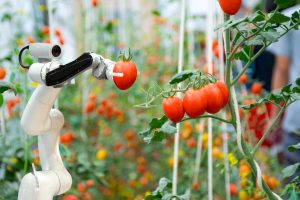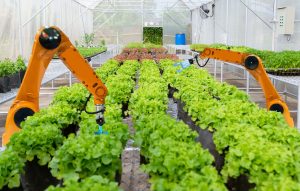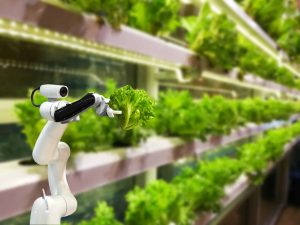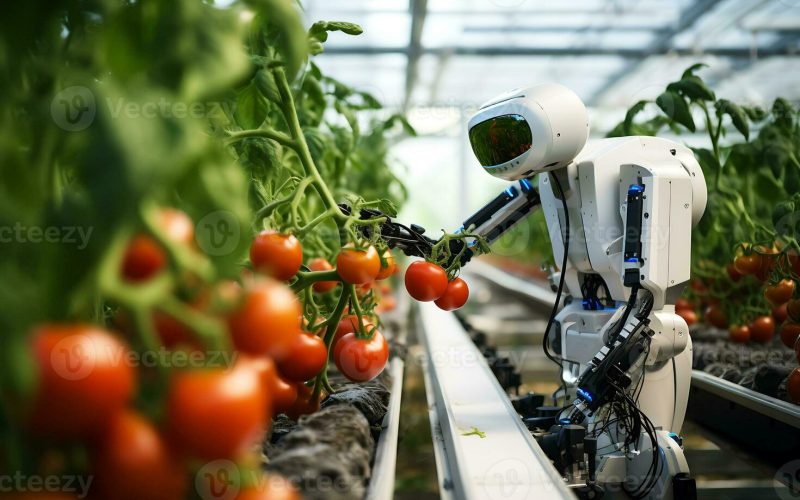Introduction
Artificial Intelligence (AI) is revolutionizing various sectors, and agriculture is no exception. The integration of AI in agriculture is proving to be a game-changer, enhancing food production efficiency and addressing many challenges faced by the industry. This article delves into the multifaceted role of AI in agriculture, exploring its applications, benefits, and future potential.
The Need for AI in Agriculture
Agriculture is the backbone of human civilization, providing the food necessary for survival. However, the sector faces numerous challenges, including climate change, pest infestations, soil degradation, and water scarcity. Traditional farming methods often fall short in addressing these issues effectively. This is where AI comes into play, offering innovative solutions to optimize agricultural practices and improve food production efficiency.
Applications of AI in Agriculture

- Precision Farming
Precision farming involves using AI technologies to monitor and manage crop fields at a micro level. AI-powered sensors and drones collect data on soil conditions, moisture levels, and crop health. This data is then analyzed to provide farmers with actionable insights, enabling them to make informed decisions about irrigation, fertilization, and pest control.
- Crop Monitoring and Disease Detection
AI algorithms can analyze images captured by drones or satellites to detect early signs of crop diseases and pest infestations. By identifying issues at an early stage, farmers can take timely measures to prevent the spread of diseases and minimize crop losses.
- Yield Prediction
Accurate yield prediction is crucial for planning and resource allocation. AI models can analyze historical data, weather patterns, and current crop conditions to predict yields with high accuracy. This helps farmers plan their harvests and manage supply chains more efficiently.
- Soil Health Management
AI-powered soil sensors can monitor various parameters such as pH levels, nutrient content, and moisture levels. This data helps farmers maintain optimal soil health, ensuring better crop growth and higher yields.
- Autonomous Machinery
AI-driven autonomous machinery, such as tractors and harvesters, can perform tasks with high precision and efficiency. These machines can operate around the clock, reducing the need for manual labor and increasing productivity.
- Smart Irrigation Systems
Water scarcity is a significant challenge in agriculture. AI-enabled smart irrigation systems use real-time data to optimize water usage, ensuring that crops receive the right amount of water at the right time. This not only conserves water but also enhances crop growth.
- Supply Chain Optimization
AI can streamline the agricultural supply chain by predicting demand, optimizing logistics, and reducing waste. This ensures that fresh produce reaches consumers in a timely manner, enhancing food security.
Benefits of AI in Agriculture

- Increased Productivity
AI technologies enable farmers to optimize their practices, leading to higher crop yields and increased productivity. This is crucial in meeting the growing global demand for food.
- Cost Savings
By automating various tasks and optimizing resource usage, AI helps farmers reduce operational costs. For instance, precision farming reduces the need for excessive use of fertilizers and pesticides, leading to cost savings.
- Sustainability
AI promotes sustainable farming practices by minimizing the use of chemicals, conserving water, and reducing greenhouse gas emissions. This contributes to environmental conservation and ensures the long-term viability of agriculture.
- Improved Crop Quality
AI-driven monitoring and management systems ensure that crops receive optimal care, resulting in higher quality produce. This benefits both farmers and consumers.
- Risk Mitigation
AI helps farmers mitigate risks associated with weather fluctuations, pest infestations, and diseases. By providing timely and accurate information, AI enables farmers to take proactive measures and minimize potential losses.
Challenges and Considerations

Despite its numerous benefits, the adoption of AI in agriculture faces several challenges. These include high initial costs, lack of technical expertise, and concerns about data privacy. Additionally, small-scale farmers in developing countries may find it difficult to access and afford AI technologies.
-
Data Privacy and Security
The widespread use of AI in agriculture involves collecting and analyzing vast amounts of data, raising concerns about data privacy and security. Farmers need assurance that their data is protected from unauthorized access and misuse.
-
High Initial Investment
Implementing AI technologies can require significant initial investment, which may be a barrier for small-scale farmers. The cost of acquiring and maintaining advanced machinery, drones, and sensors can be prohibitive for some farmers.
-
Technical Expertise
The effective use of AI in agriculture requires technical expertise, which may not be readily available to all farmers. Farmers need training and support to use AI tools effectively and interpret the data provided.
Future Prospects of AI in Agriculture
The future of AI in agriculture looks promising. As technology continues to evolve, AI solutions are becoming more affordable and accessible. Governments and organizations are also recognizing the potential of AI in agriculture and are investing in research and development. With continued advancements, AI has the potential to transform agriculture, making it more efficient, sustainable, and resilient.
-
Enhanced Integration of AI and IoT
The integration of AI with the Internet of Things (IoT) will enable more comprehensive and real-time monitoring of agricultural processes. IoT devices can provide continuous data streams to AI algorithms, enabling more accurate and timely decision-making.
-
Development of Low-Cost AI Solutions
Efforts to develop affordable AI solutions will make advanced agricultural technologies accessible to small-scale and resource-limited farmers. Companies and research institutions are working on low-cost drones, sensors, and AI software tailored for smallholder farms.
-
AI-Driven Sustainable Agriculture
AI will play a crucial role in promoting sustainable agriculture by optimizing resource use, reducing environmental impact, and enhancing resilience to climate change. AI-driven climate-smart agriculture practices can help farmers adapt to changing weather patterns and reduce greenhouse gas emissions.
Conclusion
AI in agriculture is not just a trend but a necessity in the face of growing global food demands and environmental challenges. By enhancing food production efficiency, AI is paving the way for a more sustainable and productive agricultural sector. As we move forward, embracing AI technologies will be crucial in ensuring food security and building a resilient agricultural system for future generations.










